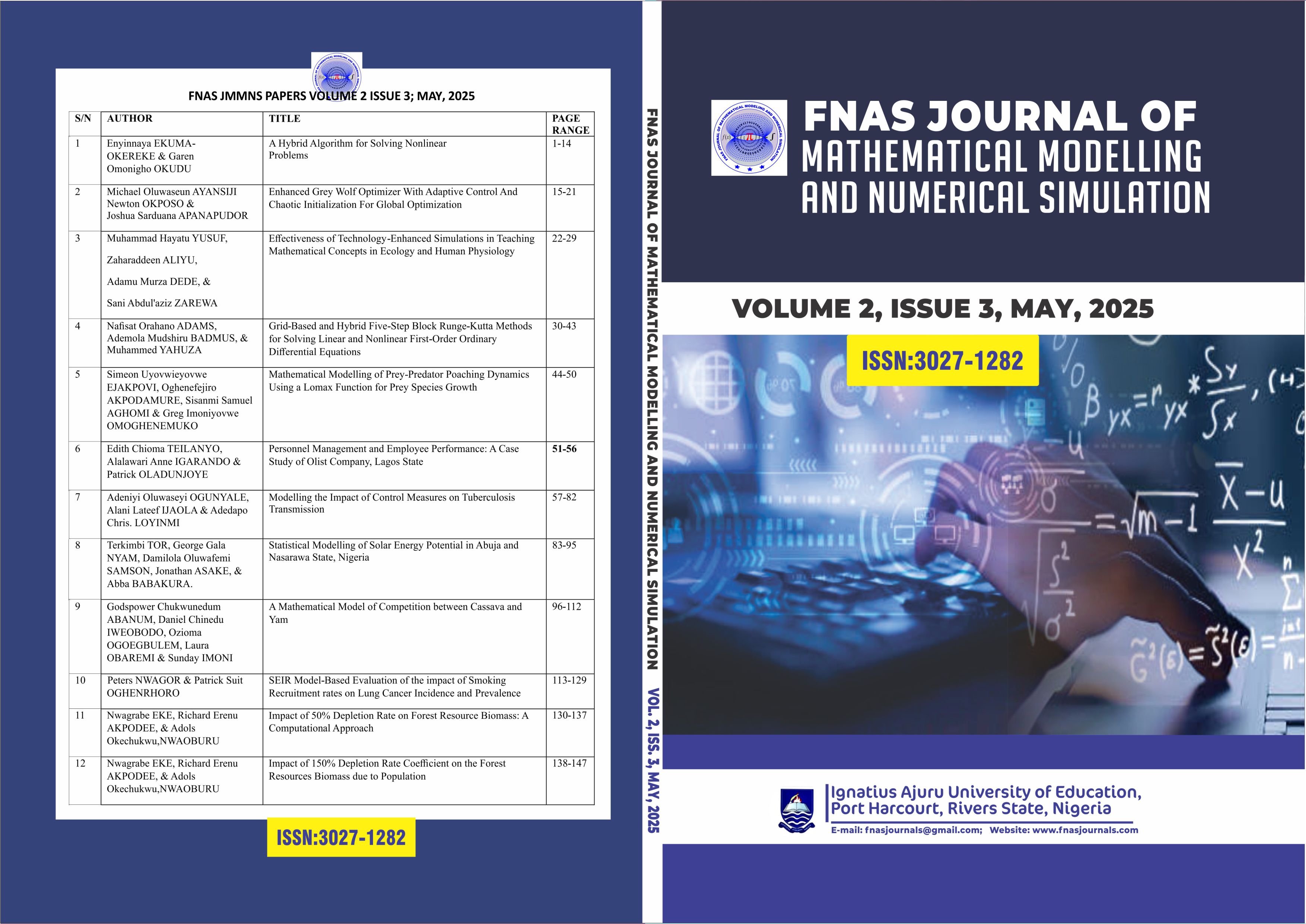Mathematical Modelling of Prey-Predator Poaching Dynamics Using a Lomax Function for Prey Species Growth
DOI:
https://doi.org/10.63561/jmns.v2i3.864Keywords:
Lomax Distribution Function, Optimal Exertion, Refuge, EnvironmentAbstract
In this paper, a Mathematical model of Prey and Predator involving Lomax distribution function is proposed and analyzed. The Lomax distribution function which is composed of exponential and gamma functions was applied on the prey growth in the absence of predator while the predator growth is logistically. The existence and the stability analysis of all possible equilibrium points are studied using the Jacobean matrix. Then, the optimal exertion is obtained by the minimization of both the prey species and predator species dynamics with respect to the exertions during the poaching process
References
Abbas, I., Ejaz, A., & Shah, S.S. (2024). Mathematical Analysis of a Predator-Prey system with shared resource, climate effect and Neural Network weight. Annals of Mathematics and Physics, 7(2), 162-173. DOI: https://doi.org/10.17352/amp.000120
Adama, H. A. (2018). Mathematical Analysis of Predator-Prey model with two preys and one predator. International Journal of Engineering and Applied Sciences, 5(11), 17-23.
Aman, A., & Dinku, T. (2021). Mathematical modelling of the dynamics of Prey-Predator with Scavenger in a closed Habitat. IOSR, Journal of Mathematics, 17(5), 8-21.
Arif, M. S., Abodayeh, K., & Ejaz, A. (2023). Stability Analysis of Fractional-Order Predator-Prey System with Consuming Food Resource. Axioms, 12(1), 64-80. DOI: https://doi.org/10.3390/axioms12010064
Ashine, A. B., & Gebru, D. M. (2017). Mathematical Modelling of Predator-Prey with modified Leslie-Gower and Holling Type II Scheme. Global Journal of Science Frontiers Research: Mathematics and Decision Sciences, 17(3), 21-40.
Bezabih, A. F., Edessa, G. K., & Rao, K. P. (2021). Ecoepidemiological model and Analysis of Prey-Predator System. Journal of Applied Mathematics. https://doi.org/10.1155/2021/6679686. DOI: https://doi.org/10.1155/2021/6679686
Charles, R., Makinde, O. D., & Kungaro, M. (2022). A Review of the Mathematical models for the Impact of Seasonal Weather variation and Infections on Prey-Predator Interaction in Serengeti Ecosystem. Open Journal of Ecology, 12(1), 718-732. DOI: https://doi.org/10.4236/oje.2022.1211041
Ejakpovi, S. U., & Siloko, I. U. (2023). A modified Logistic model for Population Growth of Fishes in an Environment. Science World Journal, 18(1), 43-47.
Ejaz, A., Nawaz, Y., Arif, M. S., Mashat, D.S., & Abodayeh, K. (2022). Stability Analysis of Predator-Prey System with Consuming Resource and Disease in Predator Species. CMES-Computer Modeling in Engineering & Sciences, 132(2), 18-24 DOI: https://doi.org/10.32604/cmes.2022.019440
Hoff, Q., & Fay, T. H. (2016). A Predator-Prey Model with Predator Population Saturation. Journal of Mathematics and Statistics, 4(4), 101-107. DOI: https://doi.org/10.13189/ms.2016.040402
Joshi, Y., Savesca, M., Syed, M., & Blackmore, D. (2021). Interesting Features of Three-Dimensional Discrete Lotka-Volterra Dynamics. Applied Mathematics, 12(3) 694-722. DOI: https://doi.org/10.4236/am.2021.128049
Kolpak, E. P., Stolbovaia, M.V., & Frantsuzova, I. S. (2016). A Predator–Prey Mathematical in a limited Area. Global Journal of Pure and Applied Mathematics, 12(5), 4443-4453.
Savitri, D. (2019). Stability and Numerical Simulation of Prey-Predator System with Holling Type II Functional Responses for Adult Prey. Journal of Physics, Conference Series, 1417. https://doi.org/10.1088/1742-6596/1417/1/012015. DOI: https://doi.org/10.1088/1742-6596/1417/1/012025
Sharmila, N. B., & Gunasundari, C. (2023). Mathematical Analysis of Prey Predator Models with Holling Type I Functional Responses and Time Delay. Communication Mathematical Biological Neuroscience, https://doi.org/10.28919/cmbn/8014. DOI: https://doi.org/10.28919/cmbn/8014
Shlyufman, K. V., Neverova, G. P., & Frisman, E. Y. (2018). Phase Multistability of Oscillatory Regimes of the Dynamics of the Rilker Model with a Periodically Varying Malthusian Parameter. Journal of Mathematical Bio information, 13(1), 68–83. DOI: https://doi.org/10.17537/2018.13.68
Simon, J. S. H., & Rabago, J. F.T. (2018). Optimal control for Predator–Prey model with disease in the prey population. Malaysian Journal of Mathematical Science, 12(2), 269-285.
Yousef, A., Salmon, S., & Elsadany, A. (2018). Stability and Bifurcation of a Delayed Predator-Prey Model. International Journal of Bifurcation and Chaos, 28, 18501161850129. https://doi.org/10.1142/S021812741850116. DOI: https://doi.org/10.1142/S021812741850116X


